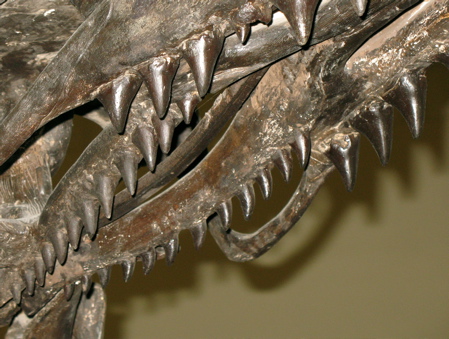 But I have forced myself away from the leathery-winged areo-beasts and will now be writing about everyone's favorite sea-monster (other than sharks)- the Mosasaurs.
But I have forced myself away from the leathery-winged areo-beasts and will now be writing about everyone's favorite sea-monster (other than sharks)- the Mosasaurs.Mosasaurs were serpentine reptiles that once inhabited the oceans worldwide. They came in many sizes and just as many varieties. They are known from every continent on the earth including Antarctica. They also were some of the very first fossil reptiles that were brought to scientific attention. Their fossils were found and described before the first dinosaur (Megalosaurus) was. It was originally thought to be a whale or a crocodile until some of the biggest names in paleontology at the time affirmed it to be a animal previously unknown some years later. The mosasaur was christened Mosasaurus hoffmanii meaning meuse-river reptile, after a local river, and was given the species name after the doctor that first gave interest in the animal. Mosasaurs were found by Lewis and Clark during their exploration of the west while trekking through Kansas. Other mosasaurs were found during other explorations of the West, including one by the German prince Maximilian von wien.
 |
| An engraving of the first mosasaur found. |
Mosasaurs were apex predators in the oceans that they thrived in. The rock layers that contain mosasaurs contain few to no other large carnivores suggesting mosasaur dominance wherever they went. They reached sizes few other predatory animals have reached, the largest mosasaur being up to 17m (~55 feet) long!
 |
| Mosasaur skin impression. |
"catch" the food to keep it from escaping out of the mouth. It would then return its lower jaw to its natural position and repeat. I personally think that they would have incorporated a wide range of feeding behavior but may have incorporated the above method as its default method.
 |
| Pterygoid teeth of a mosasaur |
Some of the features that would have allowed them to be good, long-distance swimmers would have included scales that would have encourage better aerodynamics (for some reason I do not think that is the right word), bundles of fiber that would have been under the epidermis that would have kept the skin from folding when bending which would thus reduce drag, and a dorsal vertebrae column, or the back, that was rigid while the tail was the main source for propulsive thrust. Some have even suggested that certain species of mosasaurs would have swam like a plesiosaur or penguin, utilizing underwater flight for better maneuverability in weedy enviroments. I am not too sure of that hypothesis but it is worth looking into. All of this paints a rather fearsome picture of a very well-designed aquatic predator.
But just when you thought that the rivers would have been safe (although, with crocodiles the size of school buses swimming all around you probably would not have come to that conclusion), there were mosasaurs that seemed to enjoy freshwater. Mosasaurs seem to have been just about everywhere, from Antarctica to the Arctic, N. America to Australia and even in your lakes as well.
Now when I say that mosasaurs would have eaten everything, I meant just that. There were some
 |
| Globidens dakotensis |
Mosasaurs were not social creatures at all! The fossils found with mosasaur in association with one another are either a "gravid" or, by more familiar terms but scientifically inaccurate, pregnant mother or a mosasaur is the stomach contents of another. So in other words, mosasaurs got together either for reproduction or to eat one another. Friendly animals, no doubt. Michael Everhart in Oceans of Kansas writes a list of all the mosasaurs that he is aware of (and he is aware of a lot of mosasaurs!) that were found together and they are examples of either babies prior to birth or one mosasaur ate the other one.
Mosasaurs gave birth to live young in a similar manner to snakes today. Sometimes you will see illustration of a mosasaur crawling on the beach to lay eggs like sea-turtles do but that is contrary to what we know about mosasaurs. They definitely gave birth to live young like many marine reptiles did in the past. It seems like that for many marine reptiles it was very common for them to give birth to live young instead of the typical reptilian mode of reproduction, namely laying eggs. Mosasaurs most likely would not have had any parental inclinations however. There are no reptiles today that do other than crocodilians which will often bring their babies to water and protect them. After a while though, those babies are on their own and if they were not careful, they may have become lunch for mother.
 |
| Mosasaur species found in the Midwest U.S.A |
One topic that I have not found anybody to be interested in, or at least from what I can find, concerning mosasaurs, except for a very brief reference in a fictitious story, is that of their metabolic physiology. Were mosasaurs warm-blooded or cold-blooded? I have not really formulated an opinion myself except to assume for now that they were cold-blooded. Reptiles are, for the most part, ectothermic or in other words, cold-blooded. It is probably on the safe side to assume that of mosasaurs until the evidence proves otherwise.
Sharks are all ectothermic and yet the live an active life-style in the ocean. The physical demands for living in the weightless environment of water is significantly less than that on land. Being relatively active in the water is possible for sustained periods while running on anaerobic power, especially if you are as aerodynamic as a shark or a mosasaur. But I will not be conclusive in such conclusions until I can do more research on the subject.
Well, hopefully you have an appreciation for mosasaurs after this article. The work that goes into understanding something that is interesting is very rewarding and how much more it is when you study something AWESOME... like a mosasaur. Mosasaurs were truly very amazing beasts that demand our attention beyond what they may get this June...

.jpg)
No comments:
Post a Comment